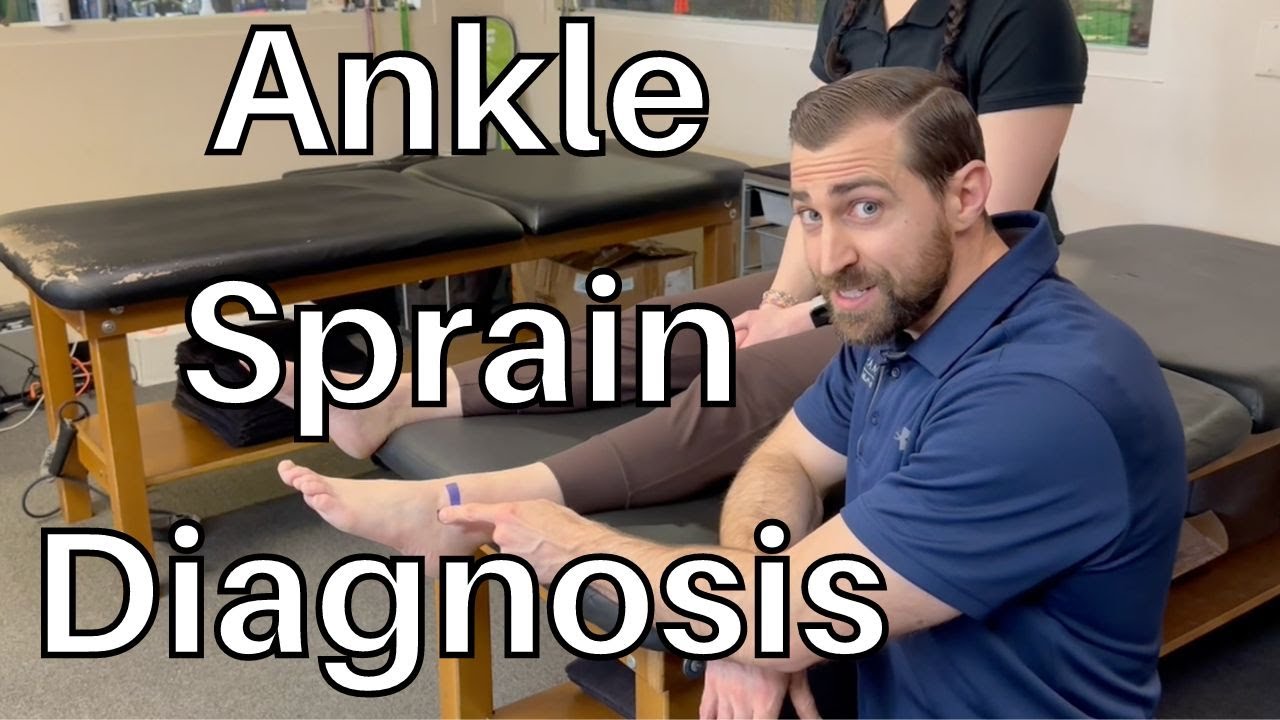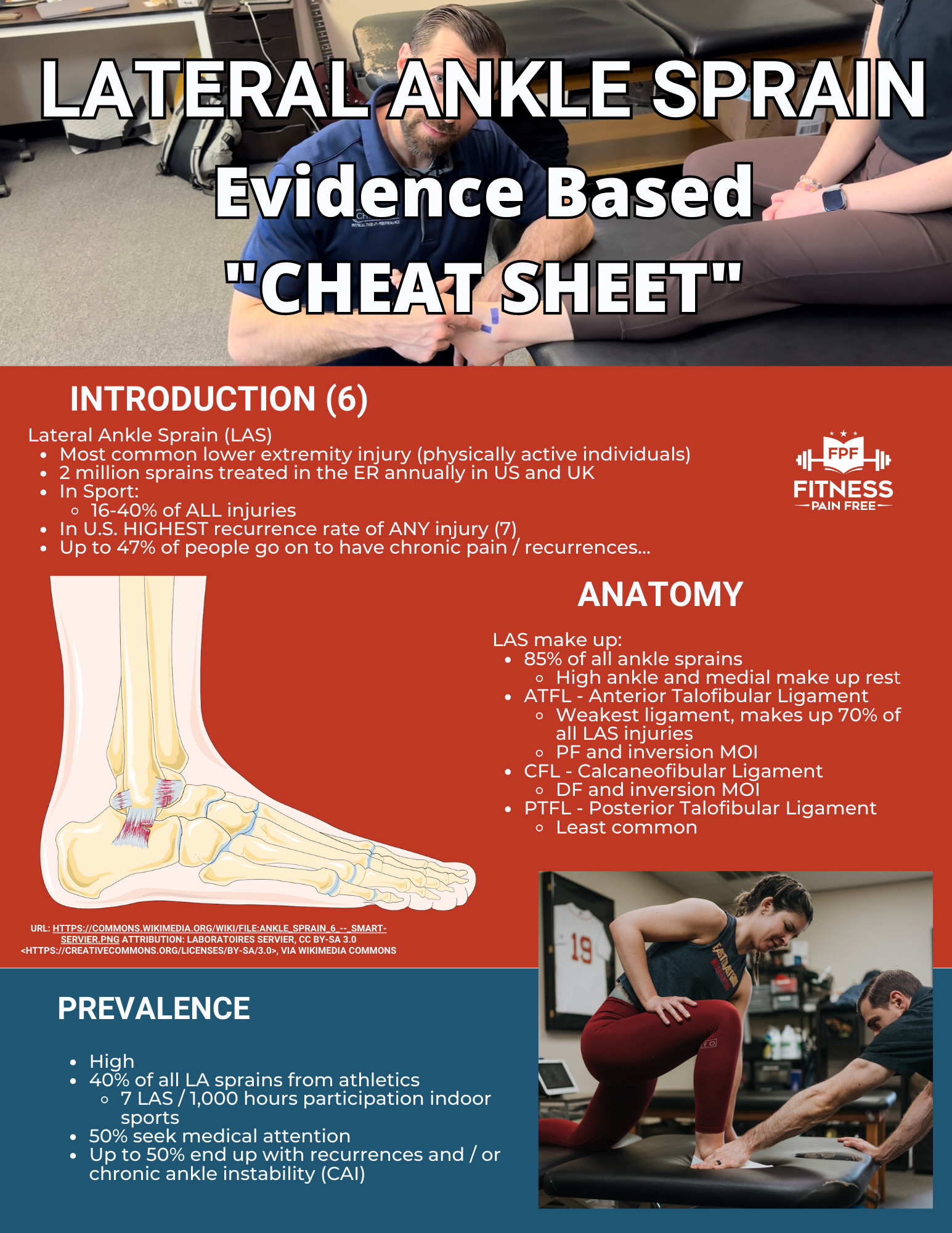
How To Diagnose an Ankle Sprain Injury:
To go along with today's video I have a free gift:
Evidence Based Lateral Ankle Sprain "Cheat Sheet" for Clinicians
Click HERE to download it for FREE:
In today's episode we go over How To Diagnose an Ankle Sprain Injury:
Welcome, fellow coaches and clinicians!
Today, we're diving into an important topic that is often overlooked in our profession: the significance of accurate diagnosis for ankle sprains. As experts in musculoskeletal health, we understand the critical role we play in guiding our patients towards recovery. A precise diagnosis is the first and foremost step towards an effective treatment plan that promotes optimal treatment plans and long-term outcomes. So let's delve into why nailing that diagnosis is paramount when it comes to ankle sprains.
- Understanding the Injury: Ankle sprains are one of the most common injuries we encounter. While they may seem straightforward, it's essential to remember that not all sprains are created equal. An accurate diagnosis enables us to determine the specific ligaments involved, the severity of the injury, and any potential accompanying factors such as fractures or soft tissue damage. This knowledge sets the stage for a targeted approach to treatment, ensuring we optimize our outcomes.
- Tailoring the Treatment Plan: An accurate diagnosis provides a solid foundation for creating an individualized treatment plan. By knowing the specific structures affected, we can design interventions that address the unique needs of our patients. For instance, a high ankle sprain may require a different rehabilitation protocol than a lateral ankle sprain. By tailoring our treatment approach, we can optimize recovery, expedite healing, and minimize the risk of re-injury.
- Mitigating Long-Term Consequences: Failing to identify and treat an ankle sprain appropriately can have long-lasting consequences. Missing a fracture and sending your patient head first into an exercise program obviously isn't a great situation. On the flip side, an under treated sprain may lead to chronic instability, recurrent injuries, and potential early-onset osteoarthritis. By accurately diagnosing ankle sprains, we can intervene promptly and effectively, reducing the likelihood of these complications and allowing our patients to regain full function and return to sport as well as their daily activities pain-free.
- Empowering Patient Education: An accurate diagnosis empowers our patients with knowledge. By explaining the specifics of their ankle sprain, its implications, and the expected recovery timeline, we can actively involve them in their treatment journey. Educating our patients about the injury promotes adherence to the rehabilitation program, encourages a positive mindset, and helps them understand the importance of following our recommendations for a successful recovery.
Check out the video below to see how I like to diagnose ankle sprain injuries and be on the lookout for concomitant pathology:
As dedicated physical therapists, accurate diagnosis forms the bedrock of our practice. For ankle sprains, it holds paramount importance in guiding appropriate treatment, mitigating long-term consequences and empowering our patients.
Let us continue to sharpen our diagnostic skills, staying at the forefront of evidence-based practice to provide the highest quality of care to those who entrust us with their recovery. Together, we can make a positive impact in the lives of our patients and contribute to their journey towards pain-free living.
Living the ankle sprain dream,
- Dan Pope PT, DPT, OCS, CSCS
Show Notes / Relevant Articles:
Want to support me and decide topics for future episodes? Click HERE to sign up for FPF "Insiders" for just a dollar. You'll gain access to 100+ webinars, e-books and complete guides. Plus, you'll get private access to the "Insiders" Facebook group where you can have all of your questions answered by me.
Looking for other ways to support me that are 100% free?
- Like, comment and share on youtube, facebook and instagram
- Leave a 5-star review on apple podcasts
Thank you!
Dan Pope DPT, OCS, CSCS
References:
Vuurberg G, Hoorntje A, Wink LM, et al Diagnosis, treatment and prevention of ankle sprains: update of an evidence-based clinical guideline British Journal of Sports Medicine 2018;52:956.
Bachmann LM, Kolb E, Koller MT, Steurer J, ter Riet G. Accuracy of Ottawa ankle rules to exclude fractures of the ankle and mid-foot: systematic review. BMJ. 2003 Feb 22;326(7386):417. doi: 10.1136/bmj.326.7386.417. PMID: 12595378; PMCID: PMC149439.
Mauntel TC, Wikstrom EA, Roos KG, Djoko A, Dompier TP, Kerr ZY. The Epidemiology of High Ankle Sprains in National Collegiate Athletic Association Sports. Am J Sports Med. 2017 Jul;45(9):2156-2163. doi: 10.1177/0363546517701428. Epub 2017 Apr 19. PMID: 28423285.
Sman AD, Hiller CE, Rae K, Linklater J, Black DA, Nicholson LL, Burns J, Refshauge KM. Diagnostic accuracy of clinical tests for ankle syndesmosis injury. Br J Sports Med. 2015 Mar;49(5):323-9. doi: 10.1136/bjsports-2013-092787. Epub 2013 Nov 19. PMID: 24255766.
- van Dijk CN, Mol BW, Lim LS, Marti RK, Bossuyt PM. Diagnosis of ligament rupture of the ankle joint. Physical examination, arthrography, stress radiography and sonography compared in 160 patients after inversion trauma. Acta Orthop Scand. 1996 Dec;67(6):566-70. doi: 10.3109/17453679608997757. PMID: 9065068.

